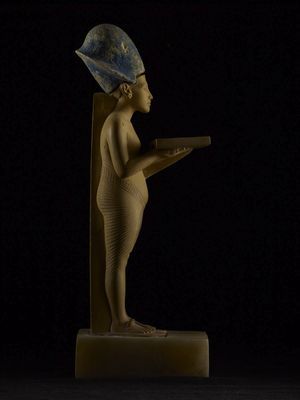
© Ken GarrettMissing: Akhenaten holding an offering table.
Sad news was announced about some of the treasures kept at the Egyptian National Museum just after Hosni Mubarak stepped down as Egypt's president.
According to Zahi Hawass, who under Mubarak was recently named minister of antiquities, some 18 objects went missing following a break-in at the museum on Jan. 28, 2011.
"The staff of the database department at the Egyptian Museum, Cairo, have given me their report on the inventory of objects at the museum following the break in. Sadly, they have discovered objects are missing from the museum," Hawass wrote in his blog.
The artifacts include a limestone statue of Akhenaten holding an offering table (previously announced to have been under restoration), and two gilded wood statues of King Tutankhamun, one of the boy king being carried by a goddess, the other of the pharaoh harpooning.
"Only the torso and upper limbs of the king are missing from this object," Hawass said, referring to the harpooning statue.
The other artifacts are a statue of Queen Nefertiti making an offering, the sandstone head of an Amarna princess, a stone statuette of a scribe from Amarna, and 11 wooden statuettes plus a heart scarab (a protective amulet for the heart) belonging to Yuya, King Tut's great-grandfather.
Hawass stated that an investigation has begun to find the people who have taken the objects, with the police and army planning to follow up with criminals already in custody.
He added that "in another terrible turn of events, on the night of 11 February, 2011 a magazine in Dahshur was broken into."
Called De Morgan's, the magazine contains large blocks and small artifacts.
"I have said if the Egyptian Museum is safe, then Egypt is safe. However, I am now concerned Egypt is not safe," Hawass said.
Egyptologists and archaeologists have reacted with sadness and disconcert to the announcement, which comes after a series of reassuring statements.
"Just a few days ago it was stated that the museum was safe and everything could be easily restored. Now official sources say that some priceless artifacts have been stolen and others are impossible to restore," Daniele Salvoldi, a doctoral candidate in Egyptology at the University of Pisa, Italy, told Discovery News.
"We hope not to hear any more bad news in the forthcoming days," Salvoldi, who runs the Facebook page Egyptologists for Egypt, said.
According to Jacques Kinnaer, a Belgian Egyptologist, creator of the Ancient Egypt website, the objects listed in Hawass' statement were indeed unique, especially the Tutankhamun statues and the artifacts from the Amarna Period, such as the Akhenaton and Nefertiti statues.
"And the quality of Yuya's ushebties and of his heart scarab is such, that the loss of these objects is very sad as well. These objects were created during one of the peak moments of the New Kingdom, just before the Amarna Period and are among the loveliest pieces of their kind," Kinnaer told Discovery News.
Several experts wonder how the missing artifacts could have gone unnoticed for more than two weeks.
"These artifacts are not just small objects. You do not need to check the database to find out that they are missing. Every simple person at the museum could have seen immediately that they are were not there," Wafaa El-Saddik, director of the Egyptian Museum until two months ago, told Discovery News.
According to classical archaeologist Dorothy Lobel King, giving conflicting accounts can only lead people to wonder.
"Hawass' previous claims that nothing was stolen from the Egyptian Museum were ... optimistic -- or bull, depending on where one stands on his pro-Mubarak politics," King wrote in her blog, which contains images of the missing pieces.
"
The timing of the admission, soon after the departure of President Mubarak, a man Dr. Hawass took to defending on various international news programs,
is also suspicious," King added.
According to twitter reports, Hawass is facing protests taking place outside his office in the Cairo suburb of Zamalek.
Changes in the Supreme Council of Antiquities are also urged by officials within the institution.
"We will not accept the continuation of the same system and the faces of corruption in the field of archeology and conservation," Hany Hanna, the Supreme Council of Antiquities' general director of conservation at Helwan, El-Saf and Atfeh Sector, wrote last week in a widely circulated message to Hawass.
Stating that "we have never listen to the rumors, and we take the positive side in that your aim was seeking for the benefit of Egypt's monuments, antiquities and its people," Hanna urged Hawass to "change the overall system of corruption and replacing it with a professional scientific management."
"We will be against you if you continued the same previous system, and will not be afraid of any trial or investigation," Hanna wrote.
Meanwhile, the Egyptologist community agrees on social networks that word must be spread as much as possible about the stolen objects.
"The more people know which items have been stolen, the more likely it is that a dealer or a collector recognises them and has the honesty to return them to the Egyptian Museum," Kinnaer said.
"Unfortunately, the two weeks that the theft has been kept a secret and even denied, have helped the thieves to cover their tracks and hide or sell the stolen artifacts," Kinnaer concluded.
The thieves has a penchant for 18th Dynasty objects. Interesting is the family they targeted! Yuya ( sometimes the mythical Joseph) great - grandfather of the Clan.
Both Akhenaten & Nerfertiti in Offfering positions.
Yuya's Heart Scarab must be a Treasure beyond belief, from the man believed to be the inspiration of Monotheism.
And the last king of the Dynasty in heavenly stupor - fishing and being cradled by a goddess.
Is someone making an altar???